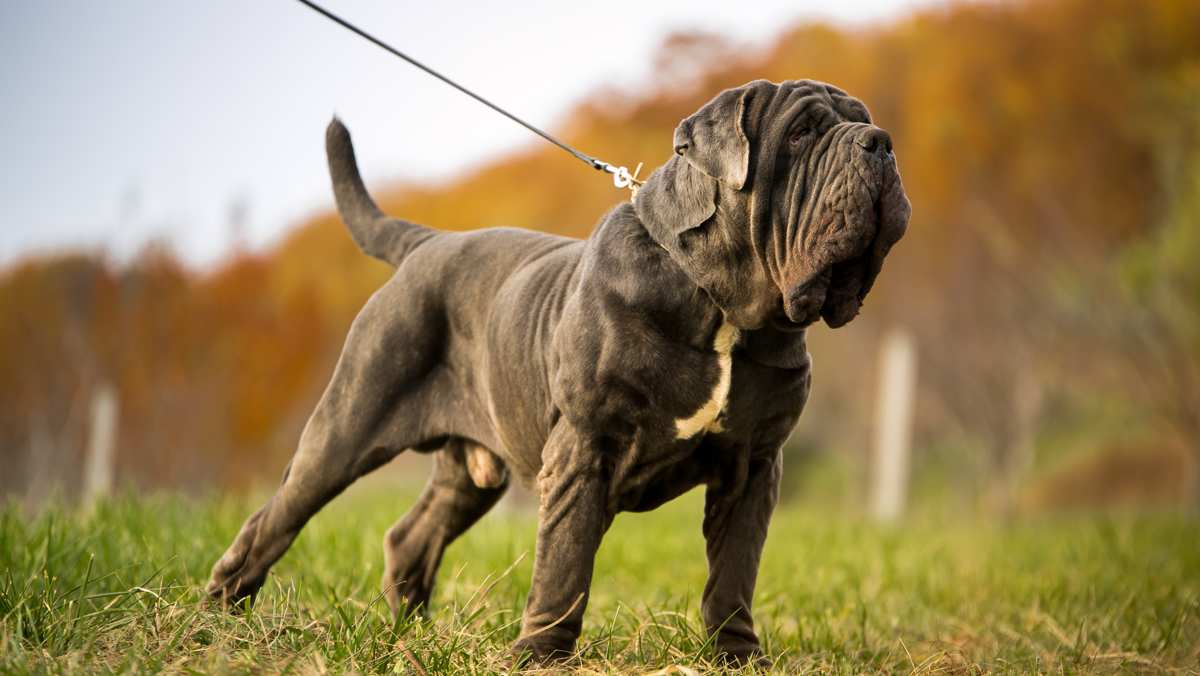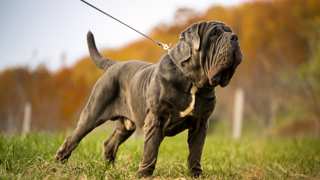Neapolitan Mastiff Dog Breed
Italian Bulldog
Italian Molosso
Mastino Napoletano
The Neapolitan Mastiff (or Mastino) is often in the top of many categories. These giants are of the largest of dog breeds, the most protective of canines, and often winners of ugliest dog competitions-- the beastly, grotesque look of the Neo is meant to send trespassers away on their heels. They are not friendly towards strangers, are not the best choice for other pets and are not hypoallergenic. Mastinos are, however, easy to groom and exercise plus very loving and loyal to their owner or family. You will never forget the folds and wrinkles, drool and lumbering run of a Neapolitan Mastiff!
Neapolitan Mastiff Breed Details
Mastinos have history as war dogs, fighting dogs and guardians. Their origin dates as far back as the time of Alexander the Great, however, the breed's ancestors were fearsome beasts of war as early as 3,000 B.C.! The modern Neapolitan Mastiff flourished in Campania, Italy as personal and estate guardians. The breed is known for quietly creeping up on intruders and handling them appropriately rather than sounding a noisy alarm. Neapolitan Mastiffs will attack if necessary to protect their owner and this can make a poorly trained one quite a liability. We recommend this breed for an experienced dog owner that is a firm leader. These dogs will do fine without a yard or a ton of exercise. Ideally, they are only pets in households that don't receive a lot of unfamiliar visitors. Here are some Neapolitan Mastiff facts about the problems and benefits of ownership:
PROS
- Excellent guard dog
- Loving and loyal
- Protective and calm around children of the household
- Easy to groom
- Doesn't require much exercise
- Unforgettable looks
- Can live indoors (apartments ok)
- Yard not necessary
CONS
- Not hypoallergenic
- Drools a lot
- Reserved around strangers
- May be jealous of kids and pets that get attention
- May be territorial towards other dogs
- Can be overprotective and aggressive if not trained and socialized early
- Not recommended for first time owner
- Difficult to train
- Not an exercise buddy
- Consider another breed if you have frequent visitors
Purebred
6 - 9 yrs.
24 - 31 in.
130 - 155 lbs
OverallFamily FriendlyChild FriendlyPet FriendlyStranger Friendly
Easy to GroomEnergy LevelExercise NeedsHealthShedding Amount
Barks / HowlsEasy to TrainGuard DogPlayfulnessWatch Dog
Apartment DogCan be AloneGood for Busy OwnersGood for New OwnersIntelligence
Neapolitan Mastiff Breed Description
The sections on this page are designed to give you the 101 on Neapolitan Mastiffs. This giant sized canine is a cool and collected guard dog that is loving with his/her family. They require little grooming maintenance or exercise but are not recommended for novice owners. A poorly trained and socialized Mastino is a big liability! The basic intelligence, activity and temperament information for the Neapolitan Mastiff is below:
Intelligence- Mastino's posess average intelligence and are independent thinkers that may be difficult for first time owners to train. They require a firm, pack leader- type owner or they run the risk of becoming overly aggressive and protective.
Kids, Strangers, Other Pets- The Neo does best as a single pet and may be territorial towards other dogs. Many owners report with early socialization they can do ok with other household pets. This breed will remain reserved around strangers, even if well trained. They are natural guard dogs and will attack if necessary. They are loving and protective towards children of their household but may not be friendly towards unfamiliar kids-- plus they pose an accidental hazard due to their large size.
Exercise- Anyone who has seen a Neapolitan Mastiff running (or lumbering, as some call it) knows that graceful, they are not. The breed is not very active and a few short walks per day will keep them happy.
Neapolitan Mastiff Breed History
Neapolitan Mastiff history may begin as early as 3,000 B.C. when ancestors of the breed (Molosser dogs of Asia, the Middle East and Northern Africa) were fearsome war dogs. Alexander the Great introduced his Mastiff type dogs to Greece in the 300 B.C. and these war dogs were later adopted by the Romans when they conquered the area. Upon invasion of England by the Romans, these already massive beasts bred with English Mastiffs to create the earliest versions and origins of the Neapolitan Mastiff. Throughout their history there are few animals the breed didn't fight-- lions, tigers, elephants, jaguars, bulls, and men. They even fought for spectacle in the Roman arenas just as the gladiators did.
As civilization advanced, the breed thrived in the Neapolitan region of Italy as guardians of owners, their families and their properties. Although the population nearly went extinct by the end of WWII the breed was still alive and well in Campania, Italy. Then, in 1946, the breed made it's first appearance at a dog show in Naples. Shortly after (1948) Dr. Piero Scanzioni presented the first breed standard and FCI acceptance followed the year after. The AKC did not recognize the breed until 2004 and in between this these times the standard was rewritten more than once. Although not extremely popular in the U.S. today's Neapolitan Mastiff is a loyal, steady guard dog with a loving nature.
Neapolitan Mastiff Appearance
Mastinos are gigantic, wrinkly beasts that look exactly like a guard dog aught to-- formidable and imposing. The abundance of skin, hanging in folds, might make one wonder if there is a smaller dog inside simply wearing a dog suit way too big for him! However, the penetrating stare will leave you with no question you are dealing with a calculating and powerful dog.
The head, itself, is very large and covered with folds and wrinkles. The lips are pendulous (hanging) and there is a significant dewlap. The eyes are amber or brown but you may not be able to make them out under the drooping upper lids; the lower lids are droopy too. Neapolitan Mastiffs often sport cropped ears but naturally they are medium sized, triangular and hanging.
Overall, the body is visibly longer than tall with a broad, deep chest and muscular, thick boned legs. The coat is short, dense and smooth and is standard in four colors: blue, black, mahogany and tawny. The tail is thick and tapering but is usually docked to 1/3 length.
Neapolitan Mastiff Colors
The images below represent the coat colors and patterns associated with Neapolitan Mastiffs.
Neapolitan Mastiff Variations
There are no alternate sizes considered as breeds of Neapolitan Mastiffs. These big, huge, GIGANTIC dogs come in the sizes of, um, big and bigger. The largest Neapolitan Mastiffs can weigh over 150 pounds! Any breeder advertising Miniature Neapolitan Mastiffs is likely crossing them with a smaller, similar looking breed, therefore, you probably won't find a purebred Mini Mastino.
Beware of hoaxes involving photoshopped pictures of Mastinos to look like 8 foot tall monsters-- while the breed is huge and imposing, they often weigh 100-150 pounds and aren't much taller than 2-2.5 ft' at shoulder height.
Neapolitan Mastiff Temperament
The Neapolitan Mastiff temperament makes for a very unique guard dog. They are watchful and protective but you won't hear them bark often. This breed is very calm and sweet with their family and enjoy being around the household; they are often loving to children in their pack. They are not aggressive towards strangers unless the situation calls for it (i.e. someone is trespassing on your property or breaking into your home) and are said to be calm yet watchful; a well trained one knows when to stand imposingly and scare away a stranger vs when to attack. It's worth mentioning these dogs need no training to be protective and will do so with their lives, if necessary.
On the flipside of this, a poorly trained Neapolitan Mastiff can have a personality that is overprotective and aggressive. This is a danger to children that wander into its territory or appear to be fighting with children of its family. These independent thinkers can be rather a lot of dog to handle for an inexperienced owner because it is imperative they get early and firm training as the "leader of the pack"-- lest they become a liability. This breed can be ok with other pets (usually) with early socialization but it is best if they live in a single pet household.
Owning a Neapolitan Mastiff is a responsibility not recommended for first time owners. They require a firm, alpha-type experienced owner. Early socialization and training is a MUST if you have frequent visitors or live in an apartment building-- speaking of apartments, you may want to see if the breed is even allowed at yours! These dogs do not bark often at all.
A large living space and fenced yard is not necessary for these low energy watchdogs. However, if you choose to let them outdoors unattended to stretch their legs, it should be in your own fenced area as they may not be stranger friendly-- for this same reason, walks should also be leashed. If you have a large property in a rural area without close neighbors, this is a breed you can let out without a fence because they tend to stick close to home.
Finally, although they are pretty low maintenance, it's important to note that Neapolitan Mastiffs are not "hypoallergenic". In addition to normal shedding there will be PLENTY of drool ropes swinging from their pendulous lips. If cleanliness is your thing-- consider another breed.
Neapolitan Mastiff Health
The Neapolitan Mastiff, like most large breeds, has a relatively short lifespan of 6-9 years. The breed has an average amount of health issues including:
- Eye problems are common and the most common one is Cherry Eye, although they are also known to have Entropion and Ectropion.
- Bloat
- Heat sensitivity
- Hip Dysplasia, Elbow Dysplasia and Pano (joint disease)
- Infections of skin folds
- Cardiomyopathy
- Hypothyroidism
- Bone Cancer
- Sensitivity to Anesthesia
Some of these issues such as Cherry Eye and Bloat are more common than the others. It should be noted the breed is especially susceptible to the Leishmania parasite. Your puppy may develop several or none of these issues and we provide them for your reference. We recommend choosing a reputable breeder that offers health certifications for the parents, at least. Routine veterinary visits are also a must to detect certain health issues early.
Neapolitan Mastiff Health Concerns
Below are potential health concerns associated with Neapolitan Mastiffs.
Bloat
Hip dysplasia
Elbow dysplasia
Cherry eye
Cardiomyopathy





